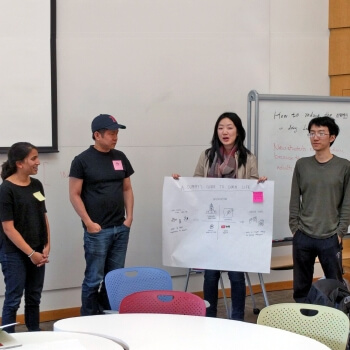News
Christine Zhang, A.B. '18, an applied math concentrator, presents the concept her group developed during the SEAS Design Thinking Workshop. (Photo provided by Christine Zhang.)
This is an excerpt of an article published by the Harvard Office for Sustainability.
“Sketch the person to your left; it’ll function as their name tag for the rest of the day.”
That immediately broke whatever ice there may have been among the 20 students who attended the five-hour Design Thinking Workshop hosted by the Harvard John A. Paulson School of Engineering and Applied Sciences at the end of March. A ripple of chuckles, and “uhh, here goes nothing...” and “sorry if this turns out terrible.” But from that moment forward, we were encouraged to be unabashedly and unapologetically outgoing in our artistic endeavors for the day: design and thought.
THE GOAL: Gain firsthand experience implementing and reimplementing the design thinking process in two scenarios: by defining, ideating, prototyping, and testing with feedback from Daniela Faas, senior preceptor in Design Instruction, Avi Uttamchandani, preceptor in electrical engineering, the Harvard Office for Sustainability, and fellow team members.
THE CLIENT: Harvard Office for Sustainability.
THE PROMPT: Find creative ways to reduce energy usage on campus and encourage students to incorporate energy considerations into everyday actions and decisions.
Here are three student excerpts on the experience and the ideas.
A Dummy’s Guide to Dorm Life: Emphasis on Laundry
Christine Zhang, A.B. candidate in Applied Mathematics, class of 2018
Daniela Faas, the head of the design thinking workshop, had us shuffle groups in the beginning of the day. I ended up sitting next to Ken, a data science master's student, Natasha, an undergraduate interested in bioengineering, and Yiqi, a fifth-year mechanical engineering student. During the ideation process, we immediately identified laundry as the issue we wanted to address since it was a lifestyle skill applicable to all students, even after graduation.
After a rapid session of brainstorming, we had three stand out ideas: AirDry, LaundryPool, and A Dummy’s Guide to Dorm Life. Yiqi, as an international student from China, shared how Chinese universities don’t have dryers but instead build rooms spanned with rows of clotheslines for students to hang their clothing to dry. Air drying is better both for the environment and the article of clothing itself, as it helps preserve the fabric’s fibers. However, space constraints for drying racks and a worry about theft led us to consider other ventures.
During the session, Daniela encouraged us to brainstorm fantastical ideas—just because the technology does not exist yet does not mean the idea isn’t valid. This led to our second idea, a laundry service based on the multi-billion dollar taxi provider Uber. Each load of laundry uses the same amount of water, independent of the quantity of clothing. Thus, it is optimal to wash full loads, however students may not always have enough laundry to do at one time. Ken proposed creating a “LaundryPool” where students could pair up to use washers and reduce the cost of doing laundry by 50 percent. I expanded on this idea with the creation of porous laundry bags, which students could use to store clothes to provide a layer of separation in the same washer. While we could see this idea implemented in a laundromat, we were not confident about its feasibility on a college campus. Thus, we turned to our final idea, "A Dummy’s Guide to Dorm Life."
In particular, our group wanted to address the excess of energy consumed by washing laundry in hot water. Laundry detergents have become so effective that current research shows no difference in the effectiveness of cold water versus hot water. Furthermore, washing with hot water uses 4.3 kW of electricity, while cold water only uses 0.3 kW, a 93 percent decrease in energy usage. We wanted all undergraduates to understand that decreasing their carbon footprint can be effortless and easy to build into habit.
We acknowledge that there needs to be better signage in laundry rooms to present a constant reminder to students to chose the “brights” (cold water) setting on washers, but we also wanted to implement more systematic changes through education. Since many students will be doing laundry for the first time when they arrive at college, we want to provide home economics training so students can see how their choices impact the environment.
Our goal was to target pre-frosh, who are generally more receptive to official Harvard emails and eager to learn. We generated a cross-platform guide to sustainability through improved signage around campus, weekly newsletters, YouTube instructional videos, and discussions during weekly entryway meetings. We planned to also use software, including AWeber, to create our email templates and help track data and analytics. Education starts early and by helping students become more aware when they are young, they will be more likely to internalize the learning.
Cutting-edge science delivered direct to your inbox.
Join the Harvard SEAS mailing list.
Press Contact
Adam Zewe | 617-496-5878 | azewe@seas.harvard.edu
